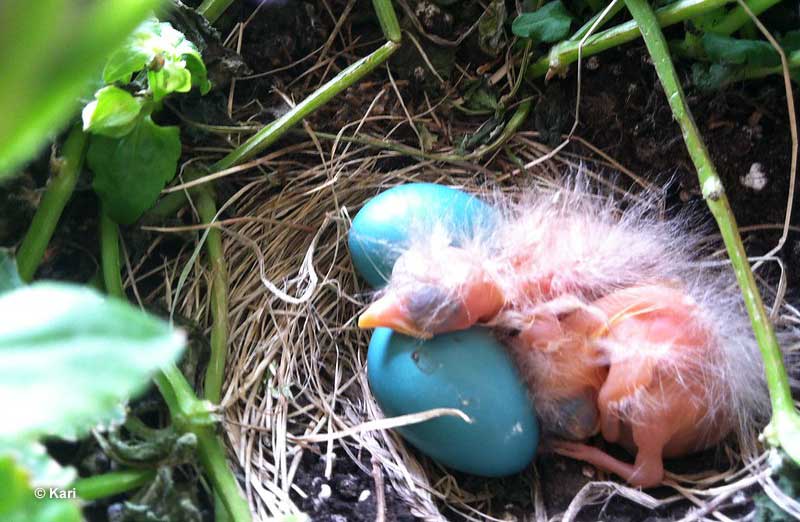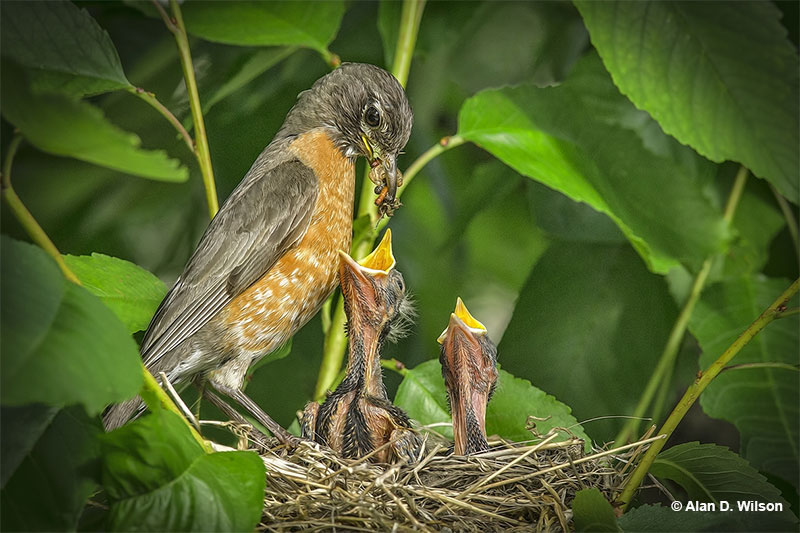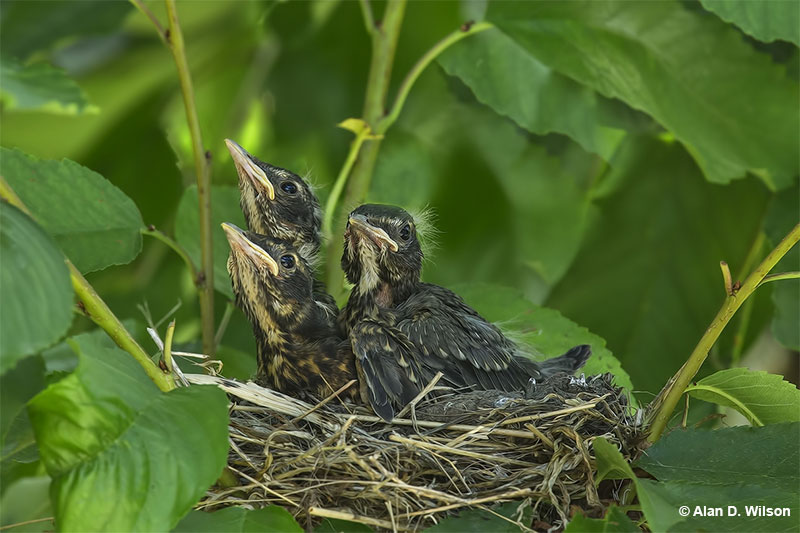
Robins nest in all sorts of places – in remote areas, but even near people. Soon after building their nest, eggs appear, and after this, time just seems to fly by!
But what happens during this magical period? How many eggs do robins lay, and are there any dangers?
Keep reading to learn everything there is to learn about the nesting behavior of robins!
What Do Robin Nests Look Like?
In most places, American Robins build their nests in early spring. In southeastern states, they can start nesting in March, but in Canada, they might not build nests until May. In the Pacific Northwest, these thrushes might even wait until June to start nesting.
However, in most parts of their range, American Robins nest in April. The female robin builds the nest, although males might help her a bit by bringing some nesting material.

She takes anywhere from one to two weeks to build her nest and makes it out of a combination of twigs, grass, rootlets, and mud. In some places, robins also use bits of white paper, plastic, and moss.
Female robins start making their nest by standing on the inside of it and making the outer wall with dead grass and twigs. After putting the bits of vegetation in place, she uses her wings to press everything together.
They then finish the wall of the nest by pressing bits of wet mud into the structure. She often uses mud castings made by earthworms and tends to make nests with thick mud walls in cold, northern regions.
The end product is an open cup nest that is around 5 inches in diameter.
Where do they build their nests?
American Robins can nest in all sorts of places. If they feel safe, these adaptable birds aren’t shy about nesting near people; they also nest in wild and remote areas.
Depending on where they occur, robins can nest in conifers, deciduous trees, and in bushes. In open habitats, they sometimes nest on the ground, and in northern regions near tundra, can even nest on cliffs.
In most places, American Robins build their nests around ten feet above the ground, usually in spots under heavy foliage. The dense vegetation acts as a roof to help shade the baby birds, protect them from rain, and help hide the nest.
In the northeastern USA, in the early part of the nesting season, robins usually make their nest in a low conifer. However, as other trees get their leaves and grow dense foliage, they build subsequent nests in maples and other deciduous trees.
Robins also frequently nest near people. It’s pretty common to find robin nests in backyards and gardens with trees and bushes. These friendly birds can also nest in planters, on ledges, and even on windowsills!
However, they usually pick sturdy branches in trees to build their nest, usually under heavy foliage.
Eggs
Robins start to lay their eggs three to four days after they finish their nest. In the northern USA, this usually takes place in April while birds that live in warmer regions can lay their first eggs earlier in the season.
Robins that live in colder places might not lay eggs until late May or even June. No matter where they occur, the female American Robin carries out all the incubation duties and lays one egg per day for three or four days.
The typical clutch size for a robin is three or four eggs. Unlike a lot of other songbirds that lay eggs at dawn, female robins lay eggs in the late morning and even in the afternoon.
Robin eggs are typically beautiful, bright blue, and don’t have any spots or speckling. The eggs are 1.1 inches long and weigh 0.22 ounces, and the mother bird starts incubating after she lays the second egg.
The eggs hatch after 12 to 14 days. During that time, the mother bird incubates for 40 minutes between breaks to forage for worms and other food.
American Robins usually have more than one nest per breeding season. In some places, they can nest two or even three times!
Baby Robins
Like most other songbirds, hatchling baby robins are helpless and mostly naked with some down feathers. Shortly after hatching, nestling Robins have translucent yellow skin, pale down, and yellow-orange beaks.
As they grow, their down becomes gray and they can move around a bit more. However, most of their movements are just related to receiving food; stretching their necks up and holding their beaks wide open to eat worms and insects.

Both parents feed the babies and bring them regurgitated food for the first four days. After that, they bring the baby robins beetles and other insects, worms, and berries.
The adults are also kept quite busy feeding their young. Each baby typically gets 35 to 40 feedings per day!
The young birds leave the nest after 13 or 14 days but stay in the general area for the next three weeks. During that time, they are still fed by their parents and males can lead them to roosting sites used by other young robins.
At four weeks of age, the baby Robins can still accept food from parents but can care for themselves. By this stage in their lives, they start to look like their parents but have heavily spotted plumage.
Robin Nesting Facts
- American Robin nests are often parasitized by the Brown-headed Cowbird. However, robins often recognize the foreign egg and remove it.
- American Robins can live for 14 years but most only survive for a couple of years.
- Female robins often decorate the outside of their nests with bits of plastic, paper, and leaves. They do this to help camouflage the shape of the nest.
- Young robins stay in the same area where they were born. In late summer and fall, they follow their parents and other local adult robins to feeding, roosting, and wintering areas.
- Robins can reuse the same nest for more than one brood, and sometimes reuse it the following year.
- Baby robins compete with each other by begging for food.
- The American Robin is the official state bird for three states; Connecticut, Wisconsin, and Michigan.
- Robins can use birdhouses as long as they have an open front and a clear, unobstructed view.
Frequently Asked Questions
How long does a robin sit on a nest with eggs?
A robin sits on a nest with eggs for 12 to 14 days, incubating their eggs.
Will a robin reuse a nest?
Robins do occasionally reuse nests. They prefer to make a new nest but can reuse or build on top of old nests.
Why do robins push eggs out of nest?
Robins push eggs out of nests to remove eggs laid by brood parasites, such as Brown-headed Cowbirds, and sometimes even the eggs of other Robins.
Why do robins eat their eggs?
Robins eat their eggs if they have a calcium deficiency, or to regain the calcium used to make the eggs.
What happens if you disturb a robin’s nest?
If you disturb a robin’s nest, the bird may become stressed and abandon the nest. If you move the nest or pick up the eggs, they might decide to abandon the nest site. They probably will not abandon their nest if it has babies.
How do you tell if a mother robin has abandoned her nest?
You can tell if a mother robin has abandoned her nest if the eggs are cold or if she hasn’t returned to the nest in two hours.
How long does a mother robin stay with her babies?
A mother robin stays with her babies for up to three weeks after they leave the nest.

